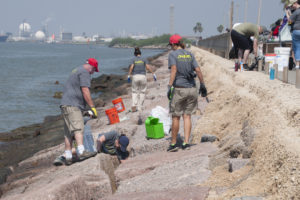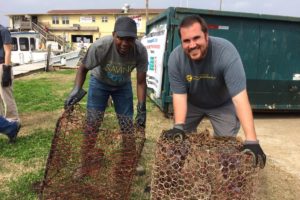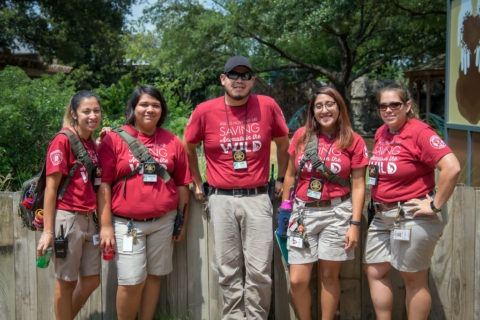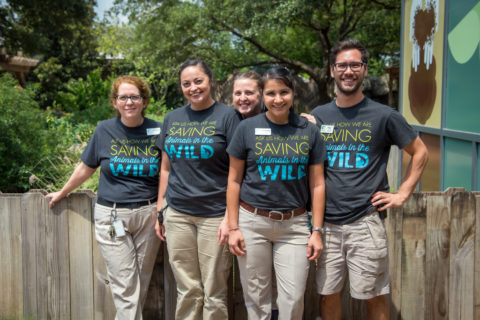Tracking Conservation Climate at the Houston Zoo
We all know that meaningful contribution to conservation is imperative to both long-term wildlife saving efforts, and to the sustainability of zoos and aquariums. But how do you take a nearly 100-year-old zoological institution and turn it into an impactful zoo-based conservation organization?
For us, the answer lies not only in connecting our community to animals but focusing on connecting our board and all 450+ staff members across 36 departments as well, empowering them to act to save wildlife. Our priority is to build and maintain a united identity of inspirational purpose, and ensure that staff feels that the Houston Zoo, and their position, is synonymous with saving animals in the wild.
In 2013, we sought to identify what the impacts of connecting staff to conservation efforts were, to collect evidence that a strong conservation climate would strengthen the Zoo. The research was conducted with 272 staff from various zoo and aquariums from around the globe, and demonstrated that zoo and aquarium employees’ connections to field conservation projects/efforts improves the following:
- Work ethic
- Ability to message conservation issues
- Passion for wildlife and conservation
- Passion for current position
- Interest in making conservation more apparent at his/her own institution
The results of this study revealed that increasing conservation connection opportunities for staff could strengthen the Zoo by improving staff work performance. With this in mind, it was critical for the Houston Zoo to further enhance and develop the conservation climate.
To accomplish this, the Zoo created Saving Wildlife Training Opportunities (SWTOs)—experiences that allow staff to gain a deeper understanding of how their positions and Zoo-wide operations are, in fact, saving wildlife.
Through a formalized structure, these opportunities ensure that staff are learning the principles of conservation while contributing to wildlife protection activities. Since implementing these opportunities in 2016, the number one benefit for participating staff reported by upper management is that their team feels supported by the Zoo, and individuals come back from opportunities feeling more connected to the Zoo’s mission of saving wildlife.
This increased sense of pride, support and connection has resulted in a perceived increase in productivity.
“I think some of the work they do can give them [staff] an appreciation for their day-to-day job,” said Hannah Bailey, curator of birds and Natural Encounters. “It also gives them satisfaction that their employer supports activities like this – this in turn provides better attitudes and higher job performance.”
Currently, the Houston Zoo offers the following opportunities to staff:
Monarch Butterfly Tagging
 By participating in this opportunity on Zoo grounds, staff members learn how to tag butterflies, record tagging data, discover more about the Monarch Watch program, and obtain information about this unique pollinator and the milkweed it needs to survive. This opportunity takes a total of 1-2 hours to participate, so it’s easy for staff to put into their schedule. To-date, 130 staff members from 27 departments have helped tag 93 butterflies.
By participating in this opportunity on Zoo grounds, staff members learn how to tag butterflies, record tagging data, discover more about the Monarch Watch program, and obtain information about this unique pollinator and the milkweed it needs to survive. This opportunity takes a total of 1-2 hours to participate, so it’s easy for staff to put into their schedule. To-date, 130 staff members from 27 departments have helped tag 93 butterflies.
Sea Turtle Survey (ended Oct. 2018)
While on the survey, staff members develop a deeper understanding of the threats to sea turtles and learn skills such as operating a GPS, tracking shrimp boats, and how to perform a sea turtle necropsy. From 2016 to 2018, 62 staff from 23 departments participated in surveying for sea turtles—responding to 14 calls about live sea turtles and assisting with 51 necropsies.
 Jetty Clean Up
Jetty Clean Up
Since 2017, 112 staff from 27 different departments dedicated time to cleaning up the jetty. These efforts have resulted in the collection of 260 pounds of monofilament fishing line, 2,796 pounds of trash, and 1,298 pounds of recycling.
Texas Bat Monitoring (Added Nov. 2018)
By participating in this opportunity on Zoo grounds, staff members learn how to monitor bats, record vocalization data, discover more about the Zoo’s partnership with Bat Conservation International, and obtain information about these unique Texans and the threats they face in the wild. This opportunity takes a total of 1-2 hours to participate, so it’s easy for people to put into their schedule. To-date, 41 staff members from 16 departments have helped detect six different bat species on Zoo grounds.
Crab Trap Clean Up

This is an annual opportunity with a partner organization, Galveston Bay Foundation, to develop a deeper understanding of the threats to otters and terrapins, and how local entities and the Zoo help. Since 2016, 33 staff members from 20 departments have removed over 780 crab traps and more than 1,000 pounds of trash, recyclable materials, and fishing line from local waterways.
Experience Follow Up
After staff members have participated in a SWTO, they are invited to a debrief session with a staff member from the Wildlife Conservation Department. The purpose of the debrief session is multi-faceted:
- Identify outcomes from staff participation
- Check to see if we are meeting the goals of the program
- Provide time to reflect on the experience and lessons learned with coworkers
- Identify components that could be strengthened in the future
- Celebrate what team members have accomplished and gained
Through these debrief sessions, progress toward achieving the Houston Zoo’s strategic plan goals is tracked. The first of which is observing a shift in staff identity to one where people feel their position is synonymous with saving wildlife.
Connectedness to Zoo’s Mission of Saving Wildlife
Before participating in a SWTO, 75.8% of respondents felt their role as a Houston Zoo employee was moderately or extremely connected to the Zoo’s mission of saving wildlife and after completing a SWTO, this percentage increased to 94.8%.
Staff Self-Efficacy in Protecting Wildlife
Similarly, when asked if they felt personally able to protect wildlife on and off Zoo grounds before their experience, 89% responded yes, which increased to 98% after participation.
 Staff Understanding and Connection to Texas Regional Conservation Programs
Staff Understanding and Connection to Texas Regional Conservation Programs
The Zoo has used closed answer questions to gauge staff understanding of, and connection to, Texas regional conservation programs. Results of staff personal experience in the field show:
- 73% of staff increase their understanding of the Zoo’s role in saving wildlife
- 69.7% of staff increase their understanding of how the Zoo partners to save wildlife
- 74.8% of staff increased their understanding of threats to wildlife in our local area
Staff Confidence to Share Personal Wildlife Success Stories with Others
The results of these questions can be tied to influencing staff’s confidence level in sharing their experiences with Zoo guests. As staff have a better understanding of how the Zoo partners to save wildlife, the more likely they are to share stories of how with the general public. Prior to a SWTO, 63% of participating staff expressed moderate to extreme confidence in sharing their own wildlife success story. Post-participation, this percentage increased to nearly 85%.
Moving Forward
Our goal is through building this conservation climate, we will see continual increases in both staff understanding that their position at the Zoo saves animals in the wild and participation in these opportunities increases from approximately 42% of staff members involved in saving wildlife activities (since 2016) to 100% (or 450 staff) by 2022. By engaging and empowering the entire Houston Zoo staff to see themselves as wildlife conservationists, we are confident we can achieve our Zoo vision to be a leader in the global movement to save wildlife.

